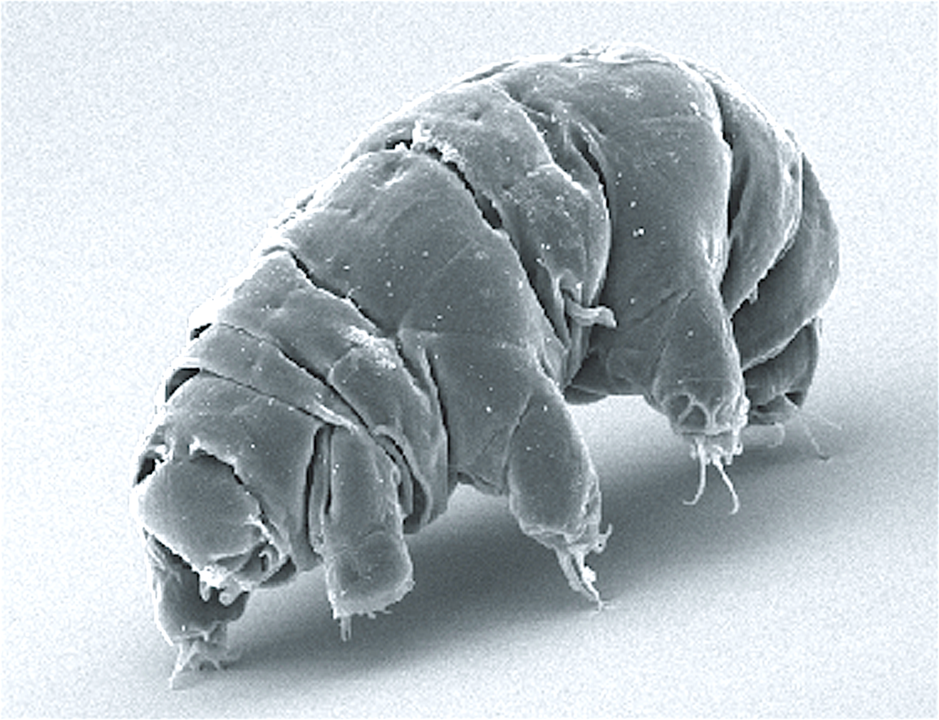
I learned this today. Tardigrades are incredibly strong and incredibly small micro-animals.
Tardigrades are generally about 0.5mm long. Some of the big ones grow up to 1.5mm in size but they are usually much smaller. There are about 1,300 different species of them and they live all over the world.
They are short and plump and they have four pairs of legs, each one with a claw or a sucker on the end of it. Because of the way they walk, they are called Bärtierchen in German, which means “little bear-animal”. Their English name, tardigrade, comes from the Latin tardi, which means slow, and gradum, which means walker.
They have four pairs of legs and they don’t have any joints. They use the back three pairs of legs to move and the front pair to grasp things. Because they have no joints and their body is segmented, they move like a bear, which is where their name comes from.
They are sometimes known as moss bears because they are often found in moss and lichen. They have a tubular mouth that they use to pierce the cells of the moss, plant, or whatever else they are eating, and release the contents of the cell.
Tardigrades have a brain and a nervous system. They have a long intestine inside them that digests all of the food they eat. They don’t breathe in the way that we do. They absorb oxygen from the water around them directly. They have a hydrostatic skeleton, which means they are filled by a fluid filled compartment inside their body which keeps them from collapsing and gives them their shape.
Tardigrades are found almost everywhere on Earth. They are known as the toughest living organism for a reason. They have been found at the top of the Himalayas and at the bottom of the sea. They have been found at the poles and at the equator. Some species can survive temperatures slightly above absolute zero and some species can survive temperatures of over 150℃. They can withstand high pressure, radiation, and even survive in a vacuum. They are not extremophiles. Extremophiles are organisms that have adapted to live in a particularly tough environment. Tardigrades haven’t done that. They have adapted to be able to endure any environment. That’s not the same as being able to live in any environment. Harsh conditions will kill them. It just takes a really long time to do so.
So, why can they survive in such harsh conditions? Their trick is dehydration. They can turn into a dehydrated ball that is called a tun. When they are in this state, they can withstand incredible extremes and then reanimate when they rehydrate. They expel more than 95% of the water in their bodies and as they shrink they curl up into a ball. Their metabolic rate slows to almost zero and their cells are protected from damage by water-soluble proteins. These proteins form a hard shell around the tardigrade’s cells keeping the contents of the cell safe.
In this way, some tardigrades actually survived in outer space. Tardigrades were taken into space in September 2007. They were exposed to the vacuum of space for 10 days. The tardigrades that were dehydrated into their tun form were mostly revived later. The tardigrades that were thrust into space in their fully hydrated state mostly didn’t survive.
Tardigrades are also able to withstand incredible impacts of up to 900 meters per second and they have been revived after being dehydrated for over a hundred years. In 1948, a scientist reanimated a tardigrade that had been in its tun state in a piece of moss that had been dried out for over 120 years. Because of all of these abilities, some scientists have suggested that tardigrades could be used to colonize Mars. They could be dehydrated and flown to Mars on a rocket. If they crashed down on an area with ice, the moisture could be enough to rehydrate them. One tardigrade needs less than 2 ml of water and they will rehydrate in about thirty minutes. Then, they may very well be able to survive in the thin Martian atmosphere.
Tardigrades are possibly the oldest continually living organisms on Earth. They evolved about 500 million years ago and they have survived every one of the five mass extinctions on Earth. In fact, scientists predict that there is very little that could wipe them out. One day, they may very well be the last living organisms on Earth. And this is what I learned today.
If you read this far, I would appreciate a like and a follow.
Image By Schokraie E, Warnken U, Hotz-Wagenblatt A, Grohme MA, Hengherr S, et al. (2012) – Schokraie E, Warnken U, Hotz-Wagenblatt A, Grohme MA, Hengherr S, et al. (2012) https://commons.wikimedia.org/w/index.php?curid=22716809
Sources:
https://en.wikipedia.org/wiki/Tardigrade
https://www.livescience.com/57985-tardigrade-facts.html
https://en.wikipedia.org/wiki/Water_on_Mars
http://cshprotocols.cshlp.org/content/2018/11/pdb.prot102327.full
